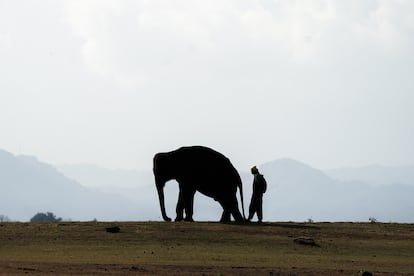Since human beings appeared, species extinction is 35 times faster
A study shows that 73 complete branches of the evolutionary tree have disappeared in the last five centuries

In a book about the future of artificial intelligence, MIT professor Max Tegmark raises an absurd and terrifying scenario: if we were unable to accurately transmit our goals to machines, they could adopt their own goals far removed from our interests, such as transforming all the atoms in the universe, including those in our own bodies, into metal paper clips. If criticized for the outlandishness of its pursuit, the mechanical mind could be forgiven on the grounds that it was trained by observing its creators. In recent decades, human intelligence has achieved an unprecedented expansion of the species by using terrifyingly efficient ingenuity to convert other living beings into food for sustaining more humans and to turn them into products to make our lives more pleasant. This species, whose ancestors experienced a critical moment in which there were little more than a thousand individuals remaining, already represents 36% of all mammals in existence. Another 60% are animals like cows, which are bred to feed people. Only 4% are wild animals.
Despite humanity’s impact on terrestrial ecosystems, we account for only 0.01% of the planet’s biomass. However, humans continue to progress, reducing space for other animals and becoming increasingly alone. This sixth mass extinction is the first one to be caused by a single animal; the previous ones resulted from meteorites — like the one that wiped out the dinosaurs — and extreme geological processes. And the impact is not limited to isolated species. According to an article published in the journal PNAS, entire branches of the evolutionary tree are being destroyed. Animals such as the Tasmanian tiger and the Yangtze dolphin were the last of their genus, the category that groups together several related species.
Led by Gerardo Ceballos, a researcher at the National Autonomous University of Mexico, the study examined 34,600 species of 5,400 vertebrate genera over the past 500 years using databases such as the International Union for Conservation of Nature database. In those five centuries, 73 genera went extinct at a rate 35 times faster than if it had kept pace with the rate of the previous 65 million years. In the absence of human influence, it would have taken 18,000 years to see so many genera disappear. According to the authors of the article, at least one-third of the known vertebrates are declining in population and being squeezed into ever-smaller ecosystems. For example, at the beginning of the 20th century, there were 10 million elephants. Today there are fewer than half a million, and they have disappeared from many of the countries they had inhabited until recently.
The loss of an entire genus can impact the functioning of a whole ecosystem. The human-imposed homogenization of their environment is also causing the equilibrium beneficial to our existence to disappear and changing the course of evolution. “In the eastern United States, large predators — bears, cougars, wolves — have disappeared, and white-tailed deer and mice have massively increased in population. Deer and mice are hosts for ticks that transmit Lyme disease, a very serious illness. This has led to millions of cases per year in the U.S.,” Ceballos explains. Less pragmatically, Paul Ehrlich, a professor at Stanford University and a co-author of the study, notes that “we are losing the only living companions we know of in the entire universe”.
In addition to increasing the spread of diseases between animals and humans, as happened with Covid-19, the loss of biodiversity and overexploitation of wild space are facilitating the destruction of resources that could be used to improve human health. Gastric brooding frogs (Rheobatrachus) were one of the genera that has disappeared. Native to the tropical forests of Queensland, Australia, these animals had a peculiar reproductive system. The females swallowed the fertilized eggs and turned their stomachs into wombs where the tadpoles grew. Since the frogs had to shut down acid secretion in their stomachs to protect their young, they were an interesting research model for diseases such as gastric reflux and associated cancers, but now there are none left on Earth. Despite their small numbers, animals like these may also play an important role in maintaining ecological balance.
Ceballos states that this data is a call to action. “If we do not act to the extent necessary, there will be a civilizational collapse. Human beings will not become extinct, but there will be [scenarios like] those apocalyptic movie situations in which only the strongest survive,” he adds. In the past, after each major extinction — which sometimes wiped out more than 70% of life on Earth — the tree of life was rebuilt as new species slowly appeared. “But that took 15 to 20 million years and humanity cannot wait that long,” warns Ceballos.
To avoid or mitigate a collapse, the authors call for unprecedented investment that pays special attention to conserving tropical forests, where the greatest biodiversity is found. “Perhaps this would cost $400 billion, which is a significant amount, but if we continue as we are now there will be a far more widespread collapse than we are seeing,” says Ceballos. Despite the knowledge that studies like the one published in PNAS offer about the extent of the ecological problem humans face, the universe’s only known intelligent species is getting increasingly close to being smothered by its own efficiency to survive and reproduce.
Sign up for our weekly newsletter to get more English-language news coverage from EL PAÍS USA Edition
Tu suscripción se está usando en otro dispositivo
¿Quieres añadir otro usuario a tu suscripción?
Si continúas leyendo en este dispositivo, no se podrá leer en el otro.
FlechaTu suscripción se está usando en otro dispositivo y solo puedes acceder a EL PAÍS desde un dispositivo a la vez.
Si quieres compartir tu cuenta, cambia tu suscripción a la modalidad Premium, así podrás añadir otro usuario. Cada uno accederá con su propia cuenta de email, lo que os permitirá personalizar vuestra experiencia en EL PAÍS.
¿Tienes una suscripción de empresa? Accede aquí para contratar más cuentas.
En el caso de no saber quién está usando tu cuenta, te recomendamos cambiar tu contraseña aquí.
Si decides continuar compartiendo tu cuenta, este mensaje se mostrará en tu dispositivo y en el de la otra persona que está usando tu cuenta de forma indefinida, afectando a tu experiencia de lectura. Puedes consultar aquí los términos y condiciones de la suscripción digital.
More information
Últimas noticias
Most viewed
- Pablo Escobar’s hippos: A serious environmental problem, 40 years on
- Reinhard Genzel, Nobel laureate in physics: ‘One-minute videos will never give you the truth’
- Why we lost the habit of sleeping in two segments and how that changed our sense of time
- Charles Dubouloz, mountaineering star, retires at 36 with a farewell tour inspired by Walter Bonatti
- The Florida Keys tourist paradise is besieged by immigration agents: ‘We’ve never seen anything like this’











































